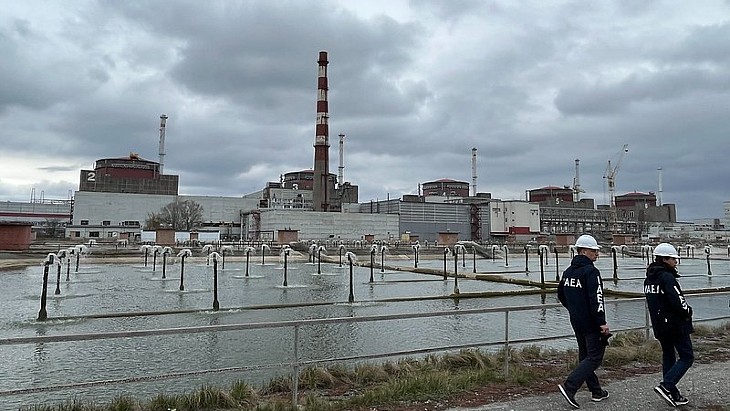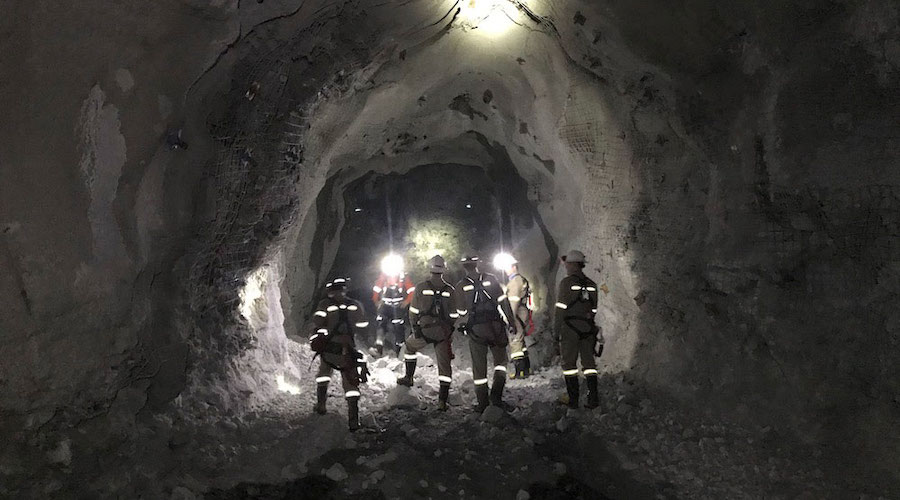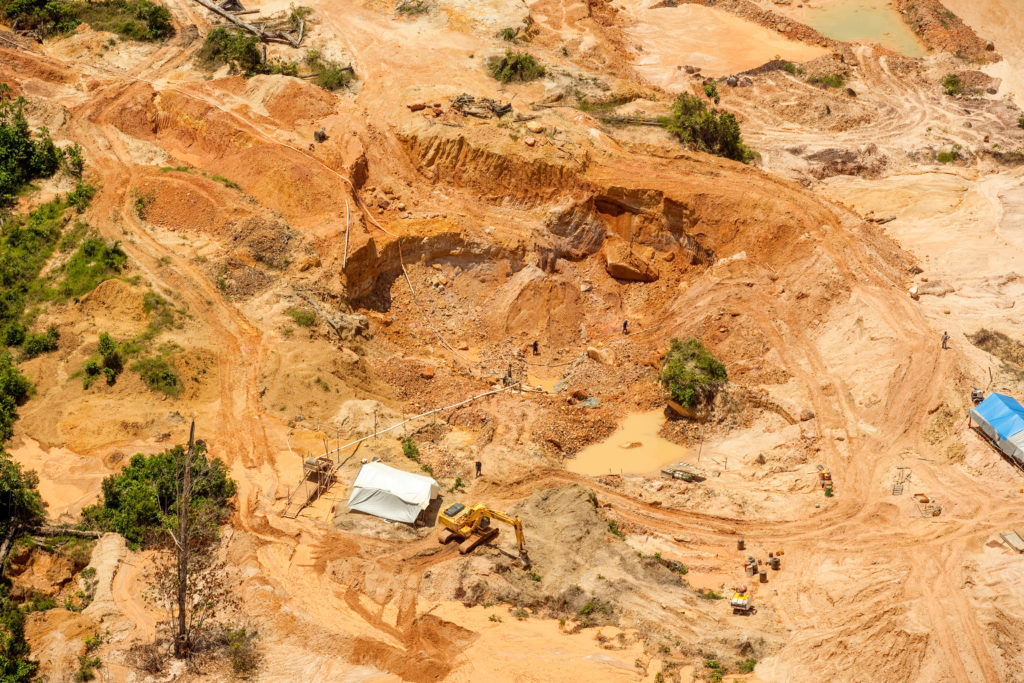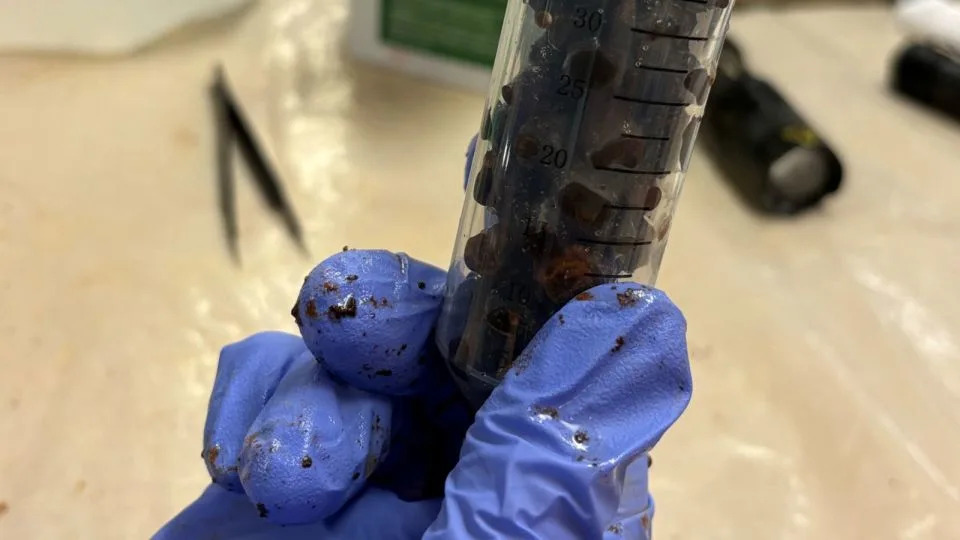GLOBAL NUKE NEWZ
Nuclear industry sets expectations of next European Commission
14 June 2024
Leaders from across the European nuclear industry have published a manifesto outlining their priorities for the new European Commission. Nuclear energy, they note, plays a crucial role in providing the EU with secure and affordable energy.
.jpg?ext=.jpg) Industry leaders present their manifesto (Image: Nucleareurope)
Industry leaders present their manifesto (Image: Nucleareurope)
Between 6 and 9 June, EU citizens voted to elect the 720 members of the next European Parliament. The new European Commission and its new President will shortly be elected.
The manifesto notes the Nuclear Alliance of the EU Member States who have committed to expanding their use of nuclear energy has recognised that nuclear could provide up to 150 GW of electricity capacity by 2050 in the EU, compared with about 100 GW currently. This commitment aligns with the Net Zero Nuclear initiative, launched in November last year during COP28, which aims to triple the world's nuclear energy capacity by 2050.
More recently, this support for the sector has also been echoed by the European Commission during the Nuclear Energy Summit in March, and with the launch of the European Industrial Alliance for Small Modular Reactors (SMRs), as well as by the European Parliament's adoption of an Own Initiative Report on SMRs.
"We have to build on this acknowledgement," the manifesto says. "For the EU to achieve a net-zero future for our society, it is imperative to fully support the pivotal role of nuclear energy alongside renewable energy sources.
"We encourage European institutions to develop an ambitious strategy to accelerate the decarbonisation and electrification of Europe's industry. This strategy should acknowledge the significant role that nuclear energy plays in enhancing the EU's strategic autonomy."
In the manifesto, nuclear industry leaders call on policymakers to: treat all net-zero technologies equally; implement consistent and coherent policies which facilitate the deployment of nuclear; allow nuclear to access EU funds and finance; include the nuclear fuel cycle as an enabling activity under the Sustainable Finance Taxonomy; ensure that low-carbon technologies are not discriminated against in taxation policies; enable innovative nuclear technologies to access EU funds beyond the Euratom programme and provide greater support for nuclear research; and support and invest in the development of a skilled nuclear workforce.
"The challenges are significant but not impossible to overcome if the European institutions, EU Member States' governments and the whole nuclear community collaborate closely to meet them," the manifesto says. "The European nuclear industry is fully committed to fulfil its role.
"It is time to turn words into actions. Together we can make a difference."
Yves Desbazeille, director general of nuclear trade body Nucleareurope, added: "Nuclear is a clean and sustainable technology which is why it essential the next Commission treat nuclear on an equal footing with other fossil free technologies. Our expectation is that future policy proposals will focus on goals - decarbonisation, competitiveness, energy sovereignty - rather than on specific technologies."
Nuclear energy generates electricity in 14 of the 27 EU Member States, and currently provides 25% of Europe's electricity and 50% of its low carbon electricity.
Estonian parliament passes nuclear resolution
14 June 2024
The Riigikogu has passed a resolution supporting the adoption of nuclear energy in the country, paving the way for the creation of the necessary legal and regulatory framework.
.jpg?ext=.jpg) (Image: Riigikogu)
(Image: Riigikogu)
The parliament based its decision on analysis conducted by the Nuclear Energy Working Group, which concluded that the adoption of nuclear energy in Estonia was feasible.
The resolution, Supporting the adoption of nuclear energy in Estonia (431 OE), says that Estonia's national development plan up to 2035 must consider the impacts of adopting nuclear energy in order to ensure security of energy supply "during the transition to climate-neutral energy production". This will include the development of a draft act on nuclear energy and safety and, if necessary, amending and supplementing existing legislation, as well as the creation of a regulatory authority for the safe use of nuclear energy, and the development of sectoral competences.
"When establishing the regulatory framework, it must be ensured that the risks related to national security, financing and form of ownership are thoroughly assessed," the resolution notes.
The explanatory memorandum that accompanies the resolution says adoption of nuclear energy in Estonia would, among other things, provide a continuous generation capacity that would balance the fluctuations in renewable energy generation capacity, help Estonia reach its climate neutrality target, ensure a stable and affordable electricity price in the long term perspective, promote research and development, bring economic benefits and create jobs for local people.
Forty-one members of the Riigikogu voted in favour of the draft resolution, with 25 voting against it and two members abstaining.
Nuclear power plant proposed for north-eastern Norway
14 June 2024
Norsk Kjernekraft has submitted a proposal to Norway's Ministry of Energy for an assessment into the construction of a power plant based on multiple small modular reactors (SMRs) in the county of Finnmark. The company said it marks the first step in the formal process to establish a nuclear power plant there.
.jpg?ext=.jpg) Vardø (Image: visitvardo.com)
Vardø (Image: visitvardo.com)In April last year, the municipality of Vardø in Finnmark proposed nearby Svartnes as a possible site for a nuclear power plant to Norsk Kjernekraft, which aims to build, own and operate SMR power plants in Norway in collaboration with power-intensive industry. Vardø municipality and Norsk Kjernekraft entered into an agreement to prepare a report with proposals for a study programme in June 2023.
In collaboration with Vardø, Norsk Kjernekraft has mapped the energy situation in Finnmark, and considered the local conditions at Svartnes. Based on this, a nuclear power plant is proposed with a capacity of up to 600 MWe and an annual output of up to 5 TWh - "enough to triple the power supply in Finnmark".
Norsk Kjernekraft said the report it has now submitted to the Ministry of Energy "describes local conditions for the construction and operation of a nuclear power plant at Svartnes outside Vardø, and which topics will be described in a future impact assessment. The available information suggests that the location is suitable for the purpose."
The scope of the proposed study programme is limited to assessing what effects construction, operation and decommissioning of the power plant can have for society and the environment. Once the proposal has been approved by the ministry, an environmental impact assessment can start.
The report says Vardø is an urban community with "a good public service offer and varied working life", and that it is therefore possible to attract the high number of employees necessary for construction and operation of the plant. Other advantages at Vardø are that there are already power lines and a substation where, combined with good road connections, ports, large areas available for both the power plant and power-intensive industry, ample access to cooling water, stable ground conditions and local political support for nuclear power. "In addition, a nuclear power plant in the far east of the country will emphasise Norway's willingness to assert sovereignty," it adds.
Norsk Kjernekraft notes that, due to limited network capacity in Vardø, it will consider alternative locations in Finnmark before the impact assessment begins.
The report says that electricity is currently generated in Finnmark using hydro plants and wind turbines. "In periods of low wind, Finnmark is dependent on supply of power from other parts of Norway and from Finland," it says. "The nuclear power plant will produce electricity completely independently of the weather, thereby providing a significant improvement in the reliability of the power supply throughout north Scandinavia, as well as helping to cover the expected power demand."
"The purpose of this notice is to inform the relevant authorities and other stakeholders that the construction of a nuclear power plant in Vardø is considered, and to invite other municipalities to report their interest in investigating alternative locations in their municipalities," Norsk Kjernekraft said.
The company said it intends to utilise a significant part of the excess heat from the plant "as an input factor for industrial companies, food production, district heating and others". It said the power plant can enable the establishment of local industry, for example within data centres, hydrogen production, mineral extraction, green shipping and food production.
Norsk Kjernekraft CEO Jonny Hesthammer commented: "A nuclear power plant in Vardø will give Finnmark access to large amounts of stable power, create hundreds of jobs and provide light in the houses in a strategically important part of our country. In addition, it will help assert Norwegian sovereignty and ensure Norwegian presence. This report will be an important part of the knowledge base for the government's announced investigation into nuclear power in Norway."
"This is a right and important step to meet future energy needs," added Vardø mayor Tor-Erik Labahå. "A nuclear power plant in Vardø will build the community in the far north-east of Norway, and it will be able to supply new industry in the entire Eastern Finnmark region."
In November, Norsk Kjernekraft submitted a proposal to the Ministry of Energy for an assessment into the construction of an SMR power plant based in the municipalities of Aure and Heim in south-western Norway. In April this year, it initiated work on the impact assessment of a plot of land in Øygarden municipality, west of Bergen, to assess the possibility of establishing a nuclear power plant comprising up to five SMRs.
A new company, Halden Kjernekraft AS, has also been founded by Norsk Kjernekraft, Østfold Energi and the municipality of Halden to investigate the construction of a nuclear power plant based on SMRs at Halden, where a research reactor once operated.
Uranium production resumes at Texas project
14 June 2024
The start-up of production at Alta Mesa - a joint venture of enCore Energy and Boss Energy - sees enCore become the only US uranium producer with multiple production facilities currently in operation and is the second start-up in eight weeks for Boss Energy. The first shipment of yellowcake is expected in 60-90 days' time.
.jpg?ext=.jpg) (Image: enCore Energy)
(Image: enCore Energy)
The previously producing in-situ leach project comprises the fully licensed and constructed Alta Mesa Uranium Central Processing Plant (CPP) and wellfield, and was acquired by enCore from Energy Fuels Inc in February 2023 for USD120 million. In December, the company entered into an agreement with Australia's Boss Energy which saw Boss acquiring a 30% stake. It is operated by enCore.
EnCore CEO Paul Goranson said the company has advanced the project from acquisition to the completion of upgrades, wellfield installation and production within fifteen months. Alta Mesa is the company's second producing asset to come online: the Rosita CPP, also in South Texas, resumed production in late 2023 after being offline since 2008, and shipped its first uranium in March.
"Our strategy at Alta Mesa is to initiate phased ramp-up from the wellfield located in Production Authorisation Area 7 (PAA-7), increasing production progressively and consistently as additional injection and recovery wells are systematically tied into the production lines," Goranson said. "As we continue to increase production from PAA-7, work has commenced on the second new wellfield at Production Authorisation Area 8 with a goal of achieving full operational capacity by 2026. We are very pleased with our initial early production providing enCore with a second revenue source as we continue to build out the Alta Mesa Project."
The Alta Mesa CPP has a total processing capacity of 1.5 million pounds U3O8 (577 tU) per year with additional drying capacity of 0.5 million pounds. It produced nearly 5 million pounds U3O8 between 2005 and 2013, when production was curtailed due to low uranium prices.
Currently, oxygenated water - used to extract uranium from the orebody - is being circulated in the wellfield through injection or extraction wells plumbed directly into the primary pipelines feeding the CPP. Expansion of the wellfield will continue with production to steadily increase from the wellfield as expansion continues through 2024 and beyond, enCore said.
In April, Boss Energy's Honeymoon project in South Australia produced its first drum of uranium in more than a decade, and Managing Director Duncan Craib said the start of production at the Alta Mesa Project is another key milestone in the company's strategy to be a global uranium supplier with a diversified production base in tier-one locations.
“With operations now ramping up at both Honeymoon and Alta Mesa, we are on track to hit our combined nameplate production target of 3 million pounds of uranium per annum," he said. "Our timing could hardly be better given the increasingly tight supply and demand fundamentals in the uranium market."
Kazatomprom gets go-ahead for Inkai 3 pilot
13 June 2024
The national atomic company has signed a new subsoil use agreement with Kazakhstan's Minister of Energy and received approval for up to four years of pilot production of a total of 701 tU from the Inkai 3 deposit.
.jpg?ext=.jpg) (Image: Kazatomprom)
(Image: Kazatomprom)
Inkai is a key uranium deposit, located in the Suzak district of Turkestan region. The Inkai 3 deposit contains uranium resources of 83,100 tU, Kazatomprom said.
"This licence is important to our sustainable development strategy. Launch of pilot production at Inkai 3 will contribute to social and economic development of the Turkestan region," Kazatomprom CEO Meirzhan Yussupov said. "Replenishment of the mineral resource base will further bolster our position as a uranium industry leader and help us to meet the rising demand for clean energy."
Kazatomprom said it expects to transfer the Inkai 3 subsoil use contract to its 100%-owned Kazatomprom-SaUran LLP subsidiary, which mines uranium from the Kanzhugan, South Moyynkum, Central Moyynkum, Uvanas and Mynkuduk deposits in the Turkestan region. Last year, it completed a major investment project to modernise its 1600 tonne per year uranium refinery in Turkestan.
The company announced its plans to start production from the new deposit in June last year, when it said it was negotiating subsoil rights based on project documents with a validity of 25 years, including the pilot production phase. At that time, it said planned to construct operating assets with an annual capacity of 4,000 tU.
All uranium production in Kazakshtan is by the in-situ leach method. JV Inkai LLP, a partnership of Canadian company Cameco (40%) and Kazatomprom (60%), produces uranium from the Inkai 1 deposit.
Sanmen 3 containment walls take shape
13 June 2024
The three steel rings forming the walls of the main containment shell have been hoisted into place at unit 3 of the Sanmen nuclear power plant in China's Zhejiang province.
.jpg?ext=.jpg) (Image: Hou Bangjun / SNERDI)
(Image: Hou Bangjun / SNERDI)
Installation of the three rings - each with a wall thickness of almost 4.5 centimetres, an inner diameter of about 39.6 metres and an overall height of about 11.6 metres - was completed on 5 June, the Shanghai Nuclear Engineering Research and Design Institute (SNERDI) announced. The total hoisting weight was about 826 tonnes.
In addition to installing temporary stiffening ribs, accessory plates, air deflector brackets, guide devices, lifting ears and other items on the shell, pipelines, electrical, ventilation, steel structures and electric winches were also installed in advance to further save the installation time of items on the island, reduce the risk of cross-operation, and improve on-site work efficiency, SNERDI said.
The construction of two new reactors at each of the Sanmen, Haiyang and Lufeng sites in China was approved by China's State Council in April 2021. The approvals were for Sanmen units 3 and 4, Haiyang 3 and 4 and units 5 and 6 of the Lufeng plant. The Sanmen and Haiyang plants are already home to two Westinghouse AP1000 units each, and two CAP1000 units were approved for Phase II (units 3 and 4) of each plant.
The CAP1000 reactor design - the Chinese version of the AP1000 - uses modular construction techniques, enabling large structural modules to be built at factories and then installed at the site. This means that more construction activities can take place at the same time, reducing the time taken to build a plant as well as offering economic and quality control benefits.
The first safety-related concrete was poured for the nuclear island of Sanmen 3 on 28 June 2022, marking the official start of its construction. The first concrete for that of unit 4 was poured on 22 March last year. The units are expected to be connected to the grid in 2027 and 2028, respectively.
Cyclotron lifted into place at Argentina's Proton Therapy Centre
13 June 2024
The 230-tonne cyclotron, which will produce proton beams for advanced cancer therapy, was lifted into the building in two stages this week.
 The cyclotron was lifted in two parts (Image: CNEA)
The cyclotron was lifted in two parts (Image: CNEA)
The centre is being built in Buenos Aires, next to the Nuclear Diagnostic Center Foundation and is a joint project between Argentina's National Atomic Energy Commission (CNEA), the University of Buenos Aires and construction company INVAP.
Luis Rovere, vice president of the CNEA, called it a "very important milestone" with the cyclotron being the main machine for the Proton Therapy Centre, which is described as the first proton centre for the treatment of cancer in the southern hemisphere. He said: "We estimate that the first tests could begin in the second half of 2025."
The operation was carried out by Belgian company Ion Beam Applications, supplier of the equipment.
The C230 cyclotron, from the Proteus Plus system, is a circular particle accelerator that produces beams of protons. It is located in a secure space with concrete walls up to four metres wide, which meant that the lifting and placing of the lower and upper halfs of the cyclotron had to be a precision operation.
According to INVAP: "Unlike the photon beam used in conventional radiotherapy, proton therapy uses high-energy protons directing higher doses to the tumour area without increasing the doses in other areas. The large mass of these protons prevents them from undergoing changes in their path to the tumour, allowing them to be more precisely directed to the affected tissues thereby minimising adverse effects on healthy tissues or organs."
The precision of the treatment, says INVAP, makes it "ideal for treating tumours that are difficult to access or surrounded by vital structures such as brain, head and neck, or lung tumours. It is also a very safe option for treating paediatric tumours since the treatment produces fewer side effects in growing bodily structures".
The Proton Therapy Centre will also offer radiotherapy with high energy X-rays and will also feature a CyberKnife linear accelerator for radiosurgery, with a robotic arm that moves and irradiates while visualising the tumour through real-time radiographic images. There will also be a magnetic resonator and a dual energy tomograph. In addition, there will be a dedicated Research, Development and Innovation laboratory at the site, separate from the clinical areas.
Researched and written by World Nuclear News
.jpg?ext=.jpg) Attitudes on the use of nuclear energy as one of the ways to provide electricity in the USA, 1983-2024 (Image: Bisconti)
Attitudes on the use of nuclear energy as one of the ways to provide electricity in the USA, 1983-2024 (Image: Bisconti) IAEA staff have been at the plant since September 2022 (Image: IAEA)
IAEA staff have been at the plant since September 2022 (Image: IAEA)
.jpg?ext=.jpg) Lecce's first visit to the Darlington New Nuclear site since becoming Minister of Energy and Electrification (Image: OPG/X)
Lecce's first visit to the Darlington New Nuclear site since becoming Minister of Energy and Electrification (Image: OPG/X).jpg?ext=.jpg) Industry leaders present their manifesto (Image: Nucleareurope)
Industry leaders present their manifesto (Image: Nucleareurope).jpg?ext=.jpg) (Image: Riigikogu)
(Image: Riigikogu).jpg?ext=.jpg) Vardø (Image: visitvardo.com)
Vardø (Image: visitvardo.com).jpg?ext=.jpg) (Image: enCore Energy)
(Image: enCore Energy).jpg?ext=.jpg) (Image: Kazatomprom)
(Image: Kazatomprom).jpg?ext=.jpg) (Image: Hou Bangjun / SNERDI)
(Image: Hou Bangjun / SNERDI) The cyclotron was lifted in two parts (Image: CNEA)
The cyclotron was lifted in two parts (Image: CNEA)




